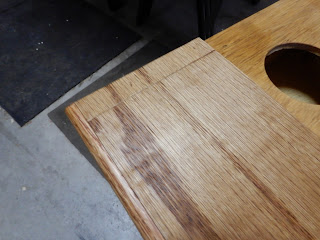It was ages ago when I made the second version of a king size bed. Recently, we bought a new bed, a "smart" adjustable one, also king size with all kinds of 'bells and whistles'. Now, what to do with the old one (first photo below) was the question. The manufacturer/merchant would only pick up the old mattress and standard frame but not the one I built.
I designed the old platform as four pieces of torsion boxes joined together by nuts and bolts as shown below. That made it easier to carry each component piece from the workshop to the bedroom, then assembled in place. It would have been impossible, otherwise, for one person to manage.
First order of business was to reverse the process - disassemble the bed back to its component pieces. A king size bed is exactly twice the dimension of a twin bed. The idea then was to make one twin for the room where there is already a queen bed, which makes that room the perfect guest room when the grand kinds come to visit.
Below are two of the four pieces. All that was needed was to add border pieces to the two untrimmed sides on each component.
Two of the rails for the frame had to be trimmed to meet the twin dimension.
Though rarely, it does happen from time to time that despite the constant reminder "to measure twice and cut once", I made a mistake. I cut two of the trim pieces short.
Tip on what to do:
Cut a 45 deg miter on the long pieces and the short pieces, join together with glue, tape and let dry. It worked.
Unless I point it out the add-on trim piece is barely noticeable.
P. S. Meanwhile, we are enjoying the new "smart" bed. The firmness is adjustable for either side. So, my wife sets her side to one level for her back support (reason we got this bed); I set mine to another. All settings, from recline (head and feet) to temperature, etc. are done either via blue tooth controls or via an app from the cell phone. Each morning, we get separate read outs from our phone as to how many hours of sleep we each got, our heart rate, breaths per minute, how many times we got up through the night (guess who gets up more?), how much restful and restless sleep (in hours and minutes) we each got, how long it took to fall asleep, how much sleep we got versus the target amount (individually set). Then we get our "sleep IQ" for each night. Isn't that awesome? For health reasons and for the fact that we all spend a third of our lives sleeping, this was worth the expense.

















No comments:
Post a Comment